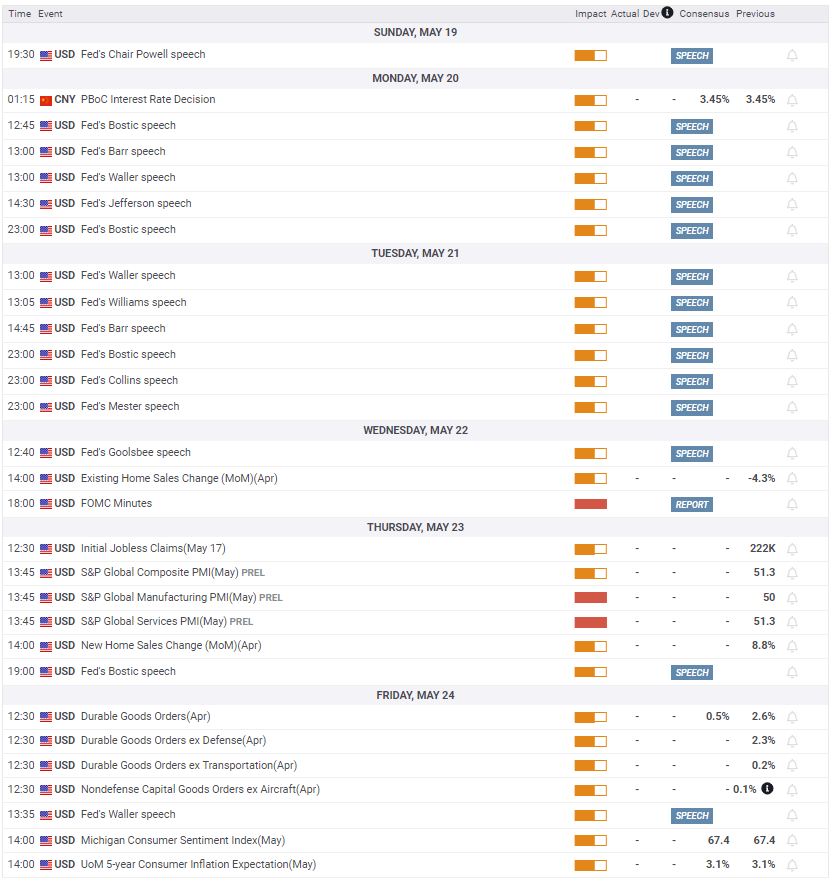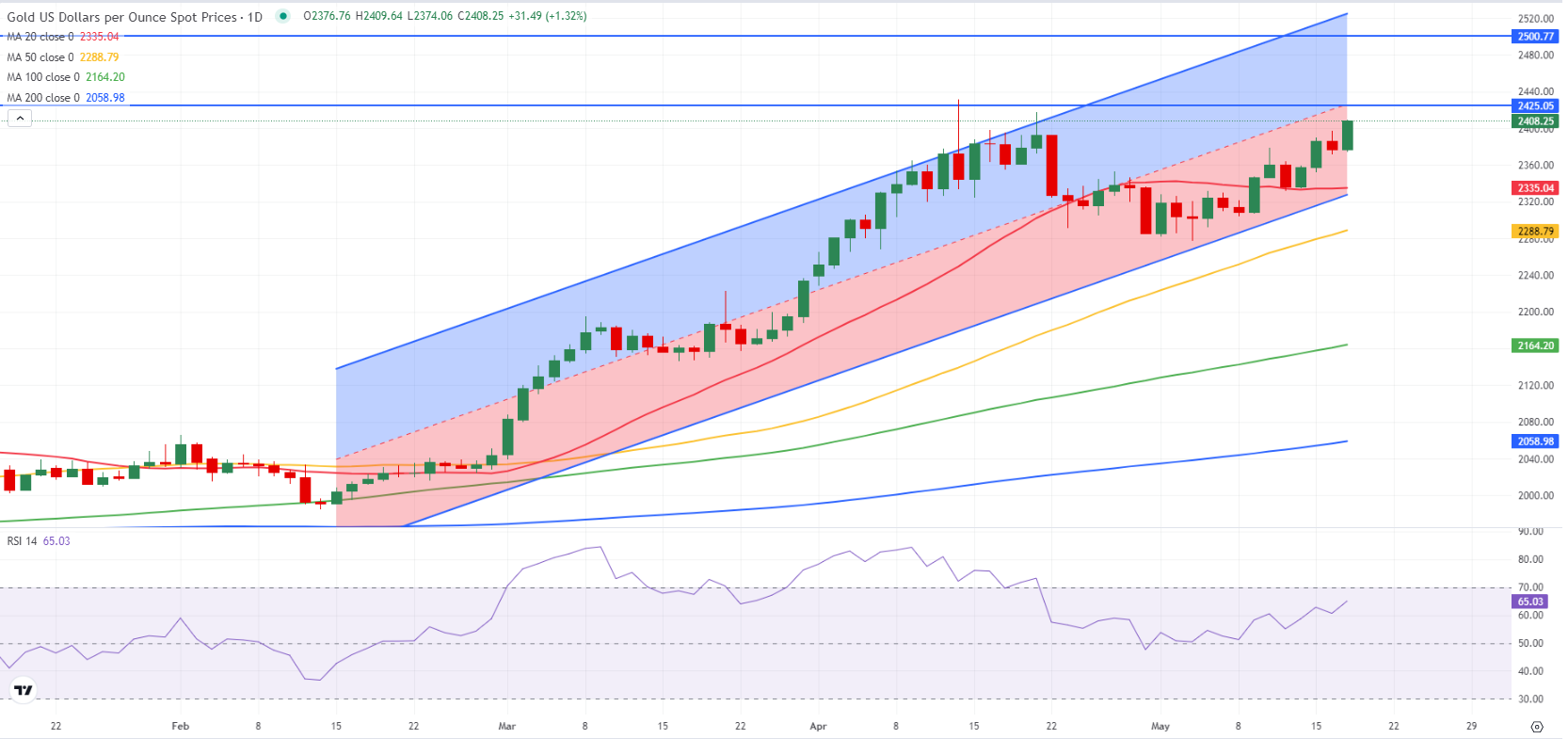- Gold built on previous weeks gains and advanced above $2,400.
- The near-term technical perspective suggests that the bullish outlook remains unchanged.
- Fedspeak and FOMC Minutes could influence XAU/USD’s action next week.
Gold (XAU/USD) price continued to push higher this week and rose above $2,400 on Friday, gaining nearly 2% for the week. Investors will continue to scrutinize comments from Federal Reserve (Fed) officials next week and look for fresh hints on the timing of the policy pivot in the minutes of the April 30-May 1 meeting.
Gold benefited from retreating US Treasury bond yields
Gold started the new week under bearish pressure and lost nearly 1% on Monday. In the absence of fundamental drivers, however, XAU/USD’s action looked to be a technical correction following the upsurge seen in the second half of the previous week.
The data published by the US Bureau of Labor Statistics (BLS) showed on Tuesday that the Producer Price Index (PPI) rose 2.2% on a yearly basis in April. This reading followed the 1.8% increase recorded in March and came in line with the market expectation. The immediate reaction to this data caused the US Dollar (USD) to weaken and allowed Gold to regain its traction. While speaking at the Foreign Bankers' Association's Annual General Meeting later in the day, Fed Chairman Jerome Powell noted that the PPI data was mixed and reiterated that the restrictive policy may take longer than expected to bring inflation down. These comments helped the USD limit its losses and capped XAU/USD’s upside.
On Wednesday, the BLS reported that annual inflation in the US, as measured by the change in the Consumer Price Index (CPI), edged lower to 3.4% in April from 3.5% in March. In the same period, core CPI inflation, which excludes volatile food and energy prices, arrived at 3.6% and met analysts’ estimates. On a monthly basis, the CPI and the core CPI both rose 0.3%. The benchmark 10-year US Treasury bond yield declined over 2% after the April inflation report and allowed Gold to push higher toward $2,400. Meanwhile, other data from the US showed that Retail Sales remained unchanged at $705.2 billion in April.
In the second half of the week, Fed officials adopted a cautious tone regarding the timing of the policy pivot and helped the USD find a foothold. In turn, Gold corrected lower on Thursday.
New York Fed President John Williams said that he doesn't see the need for a rate cut in the near term. Commenting on the April CPI reading, "kind of a positive development after a few months, where the data were disappointing," Williams told Reuters in an exclusive interview. Richmond Fed President Thomas Barkin told CNBC that the latest CPI data showed that inflation was not where the Fed was trying to get, and Atlanta Fed President Bostic argued that a continued fall in inflation could make it appropriate to reduce the policy rate later in the year.
The action in financial markets remained subdued in the first half of the day on Friday. Boosted by week-end flows, Gold turned north in the American session and reached its highest level in nearly a month above $2,400.
Gold investors await more Fedspeak, FOMC Minutes
S&P Global’s preliminary Manufacturing and Services PMI data for May will be next week’s high-tier data releases from the US on Thursday. In case these data come in below 50 and show a contraction in the private sector’s business activity, the USD could come under renewed selling pressure with the immediate reaction and open the door for a leg higher in XAU/USD. On the other hand, the USD could find demand if PMI surveys point to an acceleration in the private sector’s expansion rate.
Throughout next week, several Fed policymakers will be delivering speeches. According to the CME FedWatch Tool, markets are currently pricing in a 33% probability that the Fed will leave the policy rate unchanged in September. Although Fed officials are unlikely to say whether September will be the right time to lower the interest rates, their comments on the economic outlook and inflation developments could influence rate cut odds. If policymakers reiterate the need to see several more good monthly inflation data before considering a policy pivot, investors could reassess the probability of a rate cut in September and help the USD stay resilient, limiting Gold’s upside. In case officials voice their concerns over the loosening conditions in the labor market and/or the growing uncertainty surrounding the growth outlook, US Treasury bond yields could edge lower and allow XAU/USD to gather bullish momentum.
In the policy statement published after the April 30-May 1 meeting, the Fed said that “in recent months, there has been a lack of further progress toward the Committee's 2% inflation objective”. On Wednesday, the Fed will publish the minutes of that meeting, and investors will scrutinize policymakers’ discussions on the rate outlook in the face of the first quarter’s strong inflation readings. If the publication shows that some policymakers lean toward a single rate cut in 2024, the USD could gather strength. On the other hand, XAU/USD could extend its uptrend if the report suggests that investors are still in favor of more than one rate reduction.
Gold technical outlook
On the daily chart, the Relative Strength Index (RSI) indicator holds above 60 and Gold remains within the ascending channel coming from mid-April, reflecting the bullish bias. Once Gold confirms $2,400 (static level, psychological level) as support, it could face interim resistance at $2,425 (mid-point of the ascending channel) before $2,430 (static level) and $2,500.
On the downside, strong support seems to have formed at $2,335-$2,330, where the 20-day Simple Moving Average (SMA) and the lower limit of the ascending channel align. If this support fails, technical sellers could take action. In this scenario, $2,300 (psychological level) and $2,290 (50-day SMA) could be seen as next support levels.
Gold FAQs
Gold has played a key role in human’s history as it has been widely used as a store of value and medium of exchange. Currently, apart from its shine and usage for jewelry, the precious metal is widely seen as a safe-haven asset, meaning that it is considered a good investment during turbulent times. Gold is also widely seen as a hedge against inflation and against depreciating currencies as it doesn’t rely on any specific issuer or government.
Central banks are the biggest Gold holders. In their aim to support their currencies in turbulent times, central banks tend to diversify their reserves and buy Gold to improve the perceived strength of the economy and the currency. High Gold reserves can be a source of trust for a country’s solvency. Central banks added 1,136 tonnes of Gold worth around $70 billion to their reserves in 2022, according to data from the World Gold Council. This is the highest yearly purchase since records began. Central banks from emerging economies such as China, India and Turkey are quickly increasing their Gold reserves.
Gold has an inverse correlation with the US Dollar and US Treasuries, which are both major reserve and safe-haven assets. When the Dollar depreciates, Gold tends to rise, enabling investors and central banks to diversify their assets in turbulent times. Gold is also inversely correlated with risk assets. A rally in the stock market tends to weaken Gold price, while sell-offs in riskier markets tend to favor the precious metal.
The price can move due to a wide range of factors. Geopolitical instability or fears of a deep recession can quickly make Gold price escalate due to its safe-haven status. As a yield-less asset, Gold tends to rise with lower interest rates, while higher cost of money usually weighs down on the yellow metal. Still, most moves depend on how the US Dollar (USD) behaves as the asset is priced in dollars (XAU/USD). A strong Dollar tends to keep the price of Gold controlled, whereas a weaker Dollar is likely to push Gold prices up.
Information on these pages contains forward-looking statements that involve risks and uncertainties. Markets and instruments profiled on this page are for informational purposes only and should not in any way come across as a recommendation to buy or sell in these assets. You should do your own thorough research before making any investment decisions. FXStreet does not in any way guarantee that this information is free from mistakes, errors, or material misstatements. It also does not guarantee that this information is of a timely nature. Investing in Open Markets involves a great deal of risk, including the loss of all or a portion of your investment, as well as emotional distress. All risks, losses and costs associated with investing, including total loss of principal, are your responsibility. The views and opinions expressed in this article are those of the authors and do not necessarily reflect the official policy or position of FXStreet nor its advertisers. The author will not be held responsible for information that is found at the end of links posted on this page.
If not otherwise explicitly mentioned in the body of the article, at the time of writing, the author has no position in any stock mentioned in this article and no business relationship with any company mentioned. The author has not received compensation for writing this article, other than from FXStreet.
FXStreet and the author do not provide personalized recommendations. The author makes no representations as to the accuracy, completeness, or suitability of this information. FXStreet and the author will not be liable for any errors, omissions or any losses, injuries or damages arising from this information and its display or use. Errors and omissions excepted.
The author and FXStreet are not registered investment advisors and nothing in this article is intended to be investment advice.
Recommended Content
Editors’ Picks

AUD/USD: A challenge of the 2025 peaks looms closer
AUD/USD rose further, coming closer to the key resistance zone around 0.6400 despite the strong rebound in the Greenback and the mixed performance in the risk-associated universe. The pair’s solid price action was also propped up by a firm jobs report in Oz.

EUR/USD: Extra gains likely above 1.1400
EUR/USD came under renewed downside pressure following another bull run to the 1.1400 region on Thursday. The knee-jerk in spot came in response to the decent bounce in the US Dollar, while the dovish tone from the ECB’s Lagarde seems to have also contributed to the bearish developments in the pair.

Gold bounces off daily lows, back near $3,320
The prevailing risk-on mood among traders challenges the metal’s recent gains and prompts a modest knee-jerk in its prices on Thursday. After bottoming out near the $3,280 zone per troy ounce, Gold prices are now reclaiming the $3,320 area in spite of the stronger Greenback.

Canada launches world's first Solana ETF as $270M in staking deposits propel SOL price above BTC and ETH
Solana price jumps on Thursday as Canadian firm launches the world’s first SOL ETF, fueling bullish sentiment alongside $270 million in new staking deposits this week.

Future-proofing portfolios: A playbook for tariff and recession risks
It does seem like we will be talking tariffs for a while. And if tariffs stay — in some shape or form — even after negotiations, we’ll likely be talking about recession too. Higher input costs, persistent inflation, and tighter monetary policy are already weighing on global growth.

The Best brokers to trade EUR/USD
SPONSORED Discover the top brokers for trading EUR/USD in 2025. Our list features brokers with competitive spreads, fast execution, and powerful platforms. Whether you're a beginner or an expert, find the right partner to navigate the dynamic Forex market.

